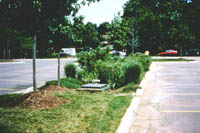|
about
us |
| Friends
of Rowan Creek rain gardens General Information • Demonstration Photos |
||
|
Rain gardens...nature's way to control runoff pollution
Introduction Despite the progress that has been made to clean up pollution during the past 30 years, Wisconsin's water resources are still endangered by polluted runoff - including excess lawn and garden pesticides and herbicides, and animal wastes draining into storm sewers. These substances find their way into the state's waterways and groundwater, producing a wide range of problems negatively affecting water quality. They ultimately have an impact on our health and economic well-being. And despite progress that has been made in flood control, the amount of runoff degrades our lakes and streams and poses a long-term threat to groundwater. Quantity
and quality of runoff is the problem Just as we all have a stake in ensuring we have clean water now and in the future, we all have the ability to do something about the problem. Every property owner can join the fight against polluted runoff by planting a rain garden. What
is a rain garden? A rain garden provides an easy, natural way of reducing the amount of water that flows from rooftops, lawns, and driveways. Runoff captured in a rain garden helps restore the natural filtration. A property might need more than one rain garden to capture and filter as much runoff as possible. Rain gardens use the concept of bioretention a practice in which plants and soils remove pollutants from storm water. And by acting as a mini-holding pond, the plants and soils of a rain garden reduce the flow of rain and melted snow from a property. How
to begin Rain gardens are very easy to establish on new residential construction. On existing lots, the hardest work involved in establishing a rain garden may involve removing grass and other plants. Most rain garden sites are created by digging a shallow depression in the landscape. Sand and/or gravel, soil, and organic mulch is layered into the garden plot if on-site infiltration is poor. The next step involves selection and placement of plants. Generally, hardy native plant species (with deep root systems) are the best choice. Should a rain garden be started from seed, from seedlings, or transplanting mature plants? The answer depends on how much money you want to spend to establish the rain garden, the time of year in which the work is undertaken, and current weather conditions. Long-term
benefits There are many benefits to having a rain garden.
And by planting a rain garden, a substantial amount of polluted runoff that affects our water resources can be filtered out efficiently and effectively - for a minimal financial investment. Using nature to protect nature is a win-win proposition for all - and a way to guarantee clean water in Wisconsin now and in the future.
Links for more info on rain gardens: http://www.mninter.net/~stack/rain/
Who
to contact for more information:
home
| about us | calendar
| projects | newsletter Friends of
Rowan Creek • PO Box 94 • Poynette, Wisconsin 53955 |
||
 of
stream habitat, reduced base flows, and a negative effect on wetlands.
Addressing these problems carries a high price tag that ultimately
shows up on tax bills.
of
stream habitat, reduced base flows, and a negative effect on wetlands.
Addressing these problems carries a high price tag that ultimately
shows up on tax bills.